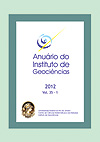Taphocoenoses of the Pimenteira Formation, devonian of the Parnaíba basin, state of Piauí: mapping, inventory and heritage relevance
DOI:
https://doi.org/10.11137/2012_1_05_27Abstract
During fieldwork conducted in the last ten years along the eastern border of the Parnaíba Basin in the State of Piauí, the continuous destruction of fossiliferous outcrops of the Pimenteira Formation has been observed and is clearly a matter of concern. In the current resumption of studies on this formation, the compilation of extensive inventories, covering all fossil groups, as well as the geological context, is a necessary means of protecting the geological heritage. The purpose of the present study is to establish the composition and mode of occurrence of the taphocoenoses and to evaluate the relative importance of the formation's numerous fossiliferous sites, thus contributing to their conservation. The inventory incorporates unpublished data obtained since 2005, information available in the literature, unpublished dissertations and theses, field notebooks, photographs from different periods, and records of Pimenteira Formation samples deposited in the scientific collections of various museums and universities. Since the pioneering work of Caster (1948), the taphocoenoses of the Pimenteira Formation have been characterized as of erratic occurrence and hosted mainly by sandstones. These initial interpretations have undergone significant changes following the 2009 excursion, which revealed new fossiliferous horizons and sites with an array of differing lithologies (siltstones, sandstones, and conglomerates). Based on this inventory, we consider the following to be the most significant outcrops: Morro Branco de Kegel; Rio Sambito; Morro do Cemitério; BR-316/km 318; Itainópolis; Riachão; São João Vermelho; and PI-466/km 12. These sites are the most frequently mentioned in the literature and some have particular historical value and also considerable diversity of taphocoenoses that provide data about the depositional environment, genesis, and age of the fossiliferous deposits. Furthermore, the fossils are better preserved and record more comprehensively the faunal and floral variations of the Devonian seas and adjacent fluvio-deltaic environments.Downloads
Download data is not yet available.
Downloads
Published
2012-06-01
How to Cite
Ponciano, L. C. M. de O. (2012) “Taphocoenoses of the Pimenteira Formation, devonian of the Parnaíba basin, state of Piauí: mapping, inventory and heritage relevance”, Anuário do Instituto de Geociências. Rio de Janeiro, BR, 35(1), pp. 5–27. doi: 10.11137/2012_1_05_27.
Issue
Section
não definida
License
This journal is licensed under a Creative Commons — Attribution 4.0 International — CC BY 4.0, which permits use, distribution and reproduction in any medium, provided the original work is properly cited.















